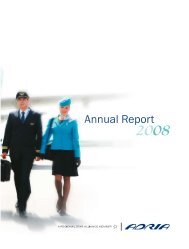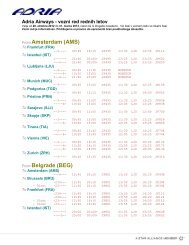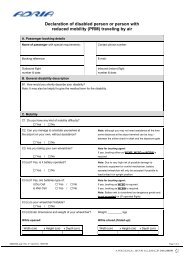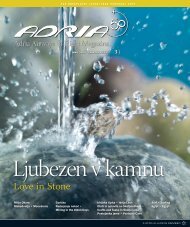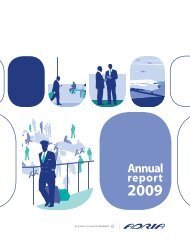København - Adria Airways
København - Adria Airways
København - Adria Airways
Create successful ePaper yourself
Turn your PDF publications into a flip-book with our unique Google optimized e-Paper software.
adventure racingA sprint lasting six hours…Adventure races differ considerably in terms of duration and length. Theshortest is known as a sprint, although it is hardly short – lasting as it doesfrom two to six hours. Sprint races are usually undemanding in orienteeringterms but can include a test of a specific skill. They usually take place in anurban environment, so they are also known as "urban adventures". Beingrelatively short and less demanding in organisational terms, sprint racesattract a large number of competitors. Longer races, lasting from six to 12hours, are as a rule more difficult from the orienteering point of view, andcompetitors are only provided with a general outline of the route. In evenlonger races lasting up to 30 hours, the organisers provide competitors withspecific information about the route. Participants have to provide their ownbackup teams to transport equipment (bicycles, boats, etc.) to the pointswhere individual trials or transitions take place (e.g. a transition from runningto cycling, etc.). Over shorter distances, backup personnel are not permittedand the transport of equipment is looked after by the organisers.In classic adventure races lasting from around 36 to 72 hours (200 to 400 km),competitors have more opportunities to choose their route, but receive a timepenalty for a missed checkpoint. Longer races, lasting from three to 11 days(500 to 1,000 km), include all the disciplines of multi-day competitions andcan be further spiced up with riding, caving, etc. Lack of sleep is an importantfactor in multi-day competitions. Competitors use their own judgement todecide when to sleep, since the race does not take place in stages but "in onego". The correct deployment of strengths, good logistics, and prevention ofdehydration and exhaustion as a result of burning up energy reserves areamong the key factors of success.Competition rules vary slightly from race to race, but generally speakingall races include the rules that no motorised travel is allowed, competitorsmust carry all gear prescribed by the organiser, and no outside assistance isallowed except at designated transition areas. Organisers may also set theirown special rules, for example that a team receives a time penalty for notkeeping together as a group, or a penalty for damaging race equipment, fordestruction of property along the course, for unsportsmanlike behaviour, forfailure to observe a stop signal when moving through a town, etc.Team spirit is essentialOn the evening or morning before a race, the organisers give the teamsinformation about the course. In the case of shorter "sprint" races, the courseis usually well marked. For longer races teams are given a map showingthe checkpoints they have to "tick off", or alternatively the organisers simplygive them coordinates. At the meeting with competitors, the organisers alsoinform them about special rules and provide other important information.Since competitors of very different abilities take part in races, two distancesare usually available. Teams that fall behind on the longer distance canswitch to the shorter one, but in this case they will be unranked at the finish.Adventure races are as a rule team competitions, and in most cases therehas to be at least one woman in the team. Teams consist of at least twomembers, while in longer races teams of four or five competitors are thenorm. All team members must reach the finish together, so many teams helpthe weakest member pre-emptively (by carrying his or her backpack, providinga tow when cycling or swimming, and so on), and should never wait solong before offering help that the weakest member is already too exhausted.Some teams appoint a team leader and divide up responsibilities, while othersprefer to improvise as they go along. Some teams are more democratic intheir decision-making, while others leave key decisions to the team leader. Inall cases, however, the success of a team depends on good cooperation.In SloveniaThe first adventure race in Slovenia took place in Velenje in 2003. The promoterand main organiser of the event, which was realised with the helpof scouts from the Velenje-based Lake Dragon troop, was Peter Vrčkovnik,who had himself previously competed for several years in adventure racesin Croatia and Austria. From these beginnings adventure racing has developedrapidly, thanks above all to the tireless efforts of Matjaž Ravnjak andhis team.Today competitors can put themselves to the test in several short "sprint"adventure races or "urban adventures". To date, races have been held in Velenje,Ljubljana, Škofja Loka, Maribor, Kranj, Kranjska Gora and Rogla. Teamsconsist of two competitors (of either gender) who choose between coursesof two different lengths – usually around 40 or 80 kilometres. Slovenia alsohosts a major international race over a course of around 400 kilometres.This race lasts approximately three days and covers the Gorenjska region,the Kamnik-Savinja Alps and the Velenje district. The location changes everyyear. Teams consist of four members, including at least one female competitor.The most successful team in the race, which counts as a qualifying event,wins the chance to take part in the world championship, held in a differentlocation every year, sometimes in mountainous terrain and sometimes evenin desert conditions. Whatever the location, however, it is sure to be a severetest of a team's endurance, team spirit and inventiveness.For more about adventureracing in Slovenia, visit:www.adventurerace.si.59



